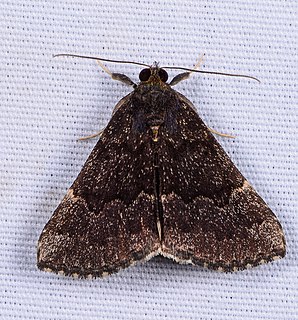
William Hodges Mann was a Virginia lawyer, Confederate soldier and Democratic politician who became the first judge of Nottoway County, Virginia and the last Confederate veteran to serve as the Governor of Virginia.

Hypena is a genus of moths in the family Erebidae. It was first described by Franz von Paula Schrank in 1802. These non-migratory moths overwinter as pupae and almost never come to bait as adults.
The Hilo noctuid moth was a moth in the family Erebidae. The species was first described by Otto Herman Swezey in 1912. It was endemic to the island of Hawaii and is now extinct.

Hypena proboscidalis, the snout, is a moth of the family Erebidae. The species was first described by Carl Linnaeus in his 1758 10th edition of Systema Naturae.
Hypena edictalis, the large bomolocha, is a moth of the family Erebidae. The species was first described by Francis Walker in 1859. It is found in North America from Quebec and Maine south to Virginia and Kentucky, west to the foothills of Alberta and the Peace River area of British Columbia.

Hypena palparia, the variegated snout-moth or mottled bomolocha, is a moth of the family Erebidae. The species was first described by Francis Walker in 1861. It is found in North America from Nova Scotia west across southern Canada to British Columbia, and south to Alabama and Texas.

Hypena lividalis is a moth of the family Erebidae. It has an Afrotropical and possibly Circumtropical distribution. It is known from the western parts of the Palearctic realm and the Neotropical realm. It is a rare migrant in western, central and northern Europe. In the Mediterranean sclerophyllous forest zone it is widespread and often abundant. In the Levant it has been recorded from Lebanon, Jordan, and Israel.

Hypena abalienalis, the white-lined hypena or white-lined bomolocha moth, is a moth of the family Erebidae. The species was first described by Francis Walker in 1859. It is found from southern Canada to northern Florida and Texas.

Hypena sordidula, the sordid hypena or sordid bomolocha moth, is a moth of the family Erebidae. The species was first described by Augustus Radcliffe Grote in 1872. It is found in North America from Quebec and Maine south to northern Florida and Texas, west to Louisiana and Kansas, north to Manitoba.

Hypena obacerralis is a moth of the family Erebidae. It is found throughout Africa, the Middle East and South Asia and Malaysia.

Hypena conscitalis is a moth of the family Erebidae first described by Francis Walker in 1866. It is found throughout Africa, from Senegal to South Africa, in South and South-East Asia as well as in Australia and on some Pacific and Indian Ocean islands.








